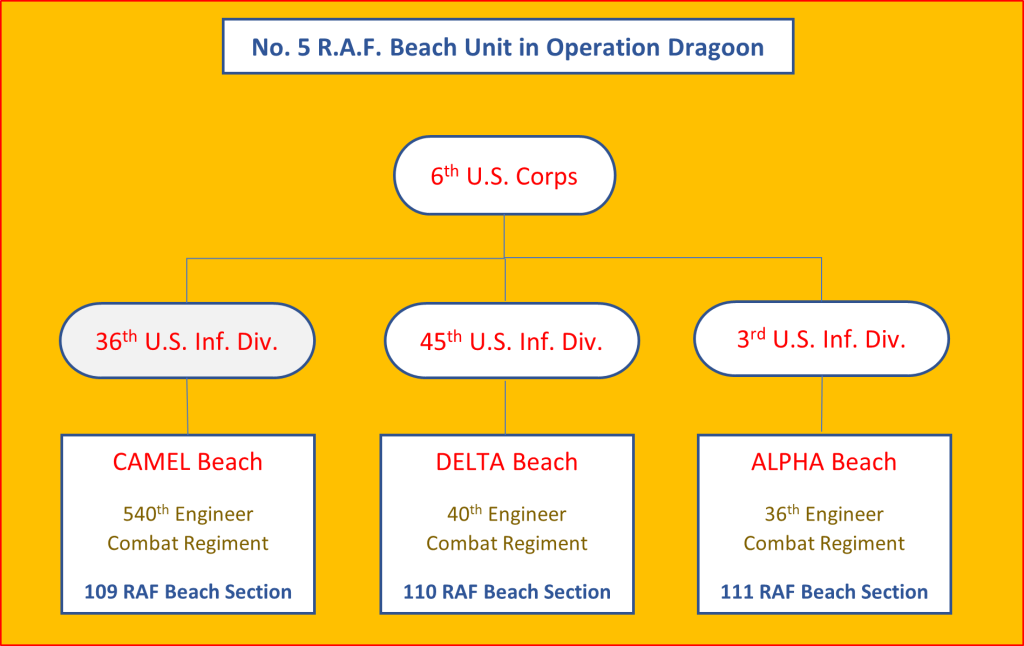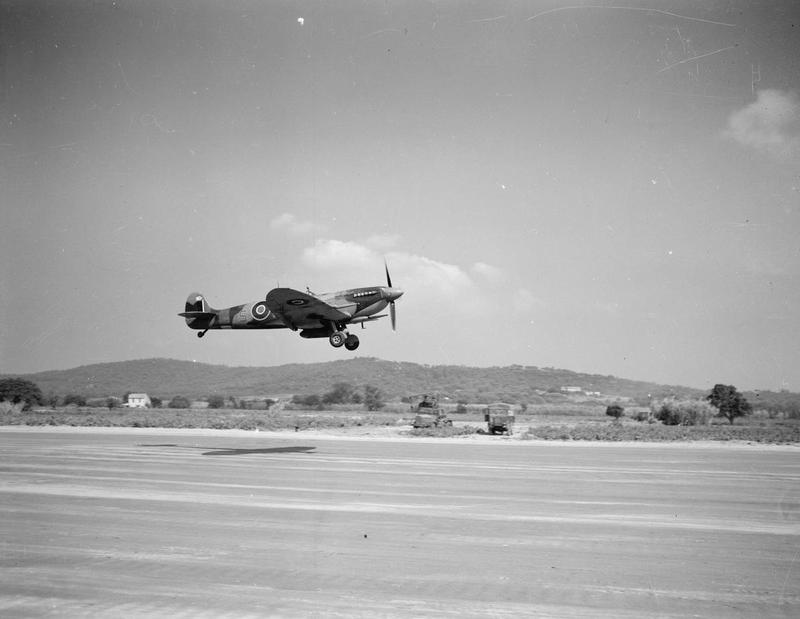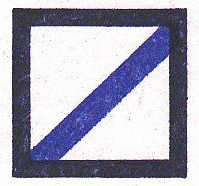Operation “DRAGOON”
Assault Landings in the South of France
D-Day, 15th August 1944
The plan to invade Southern France was originally identified by the codename “Operation ANVIL” but became known as “Operation DRAGOON” at the beginning of August 1944. The aim was to establish a beach-head east of Toulon as a base for the assault and capture of Toulon and then to capture Marseilles and exploit towards Lyons and Vichy.
In order to assist with the landing of R.A.F. units and supplies, No. 5 R.A.F. Beach Unit became part of the U.S. XII Air Force Service Command for this operation. The U.S. XII Air Force Service Command was the organisation that supplied and maintained U.S. XII Tactical Air Command. The three Sections of No. 5 R.A.F Beach Unit were each assigned to one of three beach areas and attached to an American beach maintenance organisation.

The R.A.F. Beach Sections were under the administrative control of No. 5 R.A.F. Beach Unit H.Q. (and, in turn, No. 202 Group R.A.F.) but were assigned to HQ XII Air Force Service Command for rations, quarters and duty. The R.A.F. Beach Sections came under the operational control of the U.S. Beach Control Group Headquarters. The Engineer Combat Regiments to which the R.A.F. Beach Sections were attached had the role equivalent to that of Beach Groups (or Beach Bricks) in British beach organisation.
The major components of the Mediterranean Allied Tactical Air Force were the Desert Air Force that, broadly speaking, had been supporting the 8th Army and the U.S. XII Tactical Air Command that, broadly speaking, had been supporting the 5th Army. The U.S. XII T.A.C. was earmarked for the support of Operation Anvil and was moved to Corsica.
The move of U.S. XII T.A.C. units to Corsica was completed by 18th July 1944. This had been assisted by No. 5 R.A.F. Beach Unit who from April 1944 to the beginning of July worked in the Corsican ports, Ajaccio, Bastia and Porto Vecchio. No. 5 R.A.F. Beach Unit received a commendation from Colonel Stinson, the Air Corps officer commanding Corsica Air Sub Area for this work, which was endorsed by Brigadier General Thomas, officer commanding U.S. XII Air Force Service Command.
From 10th August U.S. XII T.A.C. was dedicated to the support of Operation DRAGOON, leaving D.A.F. to provide tactical air support in Italy. U.S. XII T.A.C. included three R.A.F. fighter wings plus an R.A.F. tactical reconnaissance squadron. (It also included some Free French squadrons.)
As with previous amphibious operations it was important to operate fighter aircraft ashore as soon as possible after the assault landings. To begin with, it was planned to have 15 airfields available by D + 25 and that aircraft based in Corsica would be flown in to operate from these airfields as soon as they became available. Due to the fact that the R.A.F. fighter wings in U.S. XII T.A.C. would be moving into mainland France, No. 5 R.A.F. Beach Unit was assigned to help look after R.A.F. units and stores landing across the invasion beaches.
Having returned from Corsica to Naples, No. 5 R.A.F. Beach Unit began preparing for the DRAGOON landings. No. 109 R.A.F. Beach Section was attached to the 540th Engineer Combat Regiment, No. 110 R.A.F. Beach Section was attached to the 40th Engineer Combat Regiment and No. 111 R.A.F. Beach Section was attached to the 36th Engineer Combat Regiment. When 111 R.A.F. Beach Section took part in a beach landing exercise with the U.S. 3rd Division on 24th July, the senior officers acting as umpires remarked upon the fact that only the R.A.F. Beach Section personnel moved over and off the beach in ‘Double Time’.
No. 5 R.A.F. Beach Unit sailed with the assault forces from Naples and landed on D-Day 15th August. The Unit was busy with beach work for over a month and at the end of September received a commendation for their efforts from Major Ramsey, Air Corps officer commanding the Air Force Beach Group. This, also, was endorsed by Brigadier General Thomas, commanding officer of U.S. XII Air Force Service Command who commented, “It is a pleasure to pass on to you this tangible evidence of the close cooperation between British and American units in the field.”

The information on this page comes from the following sources:
Jackson, General Sir W., “The Mediterranean and Middle East Vol. 6, Victory in the Mediterranean Part 2 – June to October 1944”, HMSO 1986
The Operations Record Book of No. 5 R.A.F. Beach Unit found in, ‘Air Ministry and Ministry of Defence: Operations Record Books, Miscellaneous Units’ AIR 29/438 at the National Archives.
